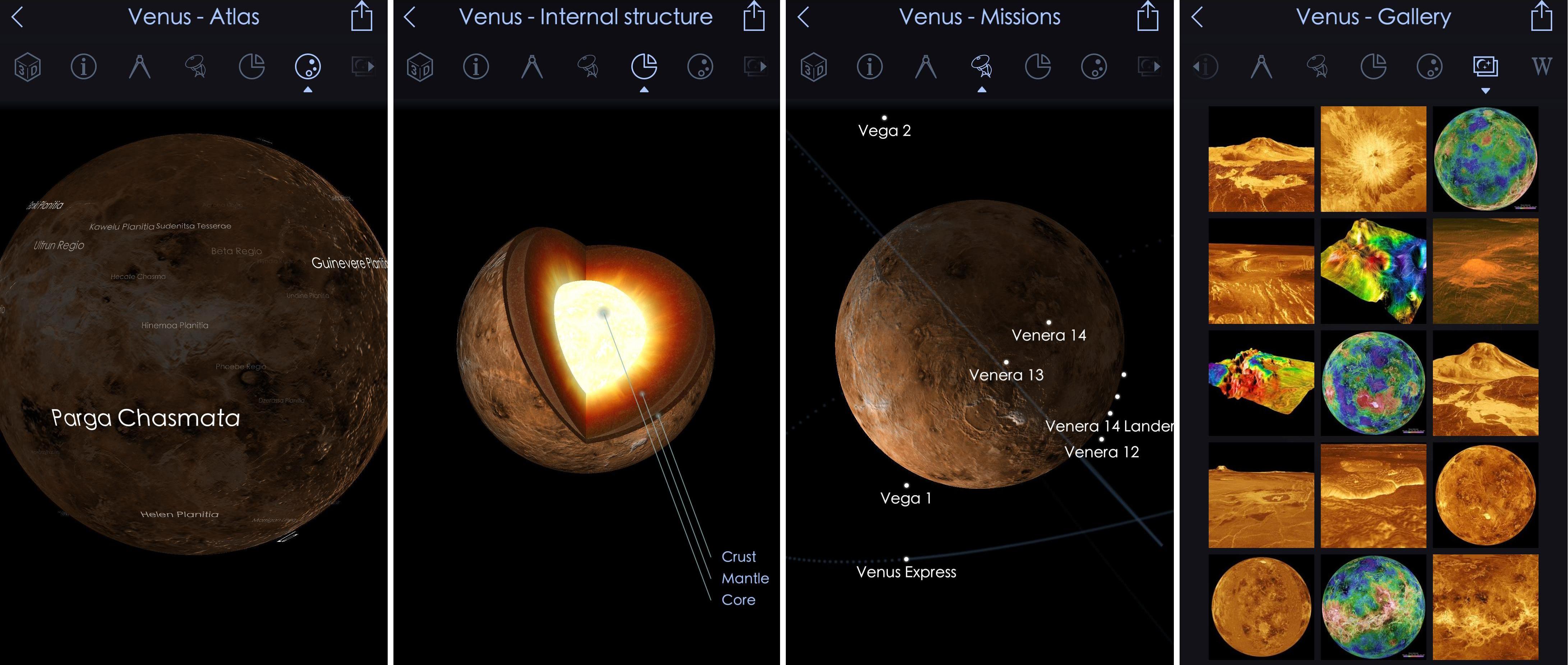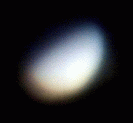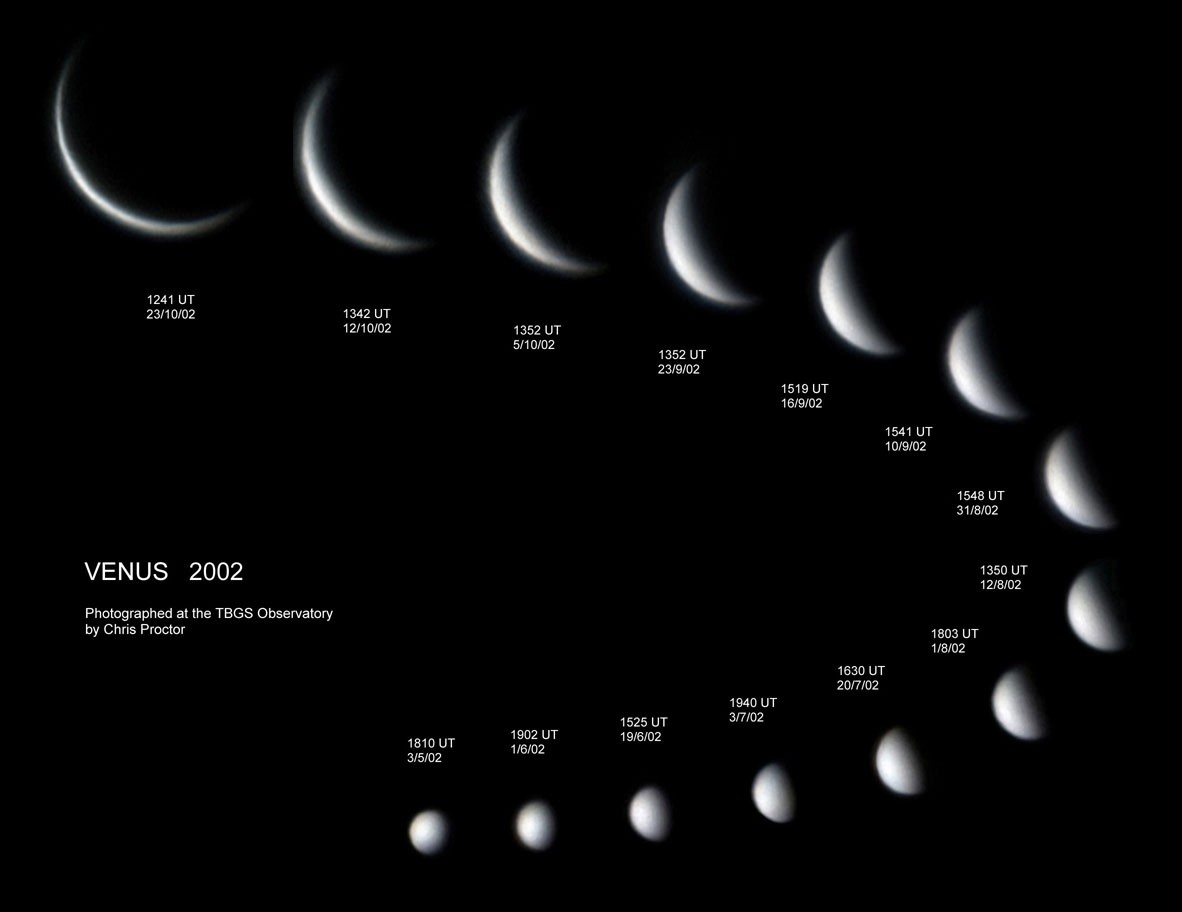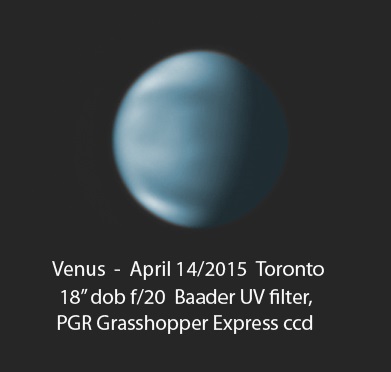Admiring the Beauty of Venus with Mobile Astronomy Apps

From now through the end of winter, the eye-catching planet Venus will shine brilliantly in the western evening sky. It's been hugging the horizon for months, but the turn of the seasons will soon lift it higher, to an ideal observing location even in a small telescope. Venus' orbit between the Earth and the sun creates a number of interesting phenomena in the way it looks and moves. In this edition of Mobile Stargazing, we'll look at Venus' properties using planetary apps, explain the motion of the planet through the sky, and provide some tips for observing and photographing the "Evening Star."
What's Venus like?
In many respects, Venus is Earth's sister planet. Its radius is only 5 percent smaller than Earth's, and it's 18 percent less massive than our planet. Its mean distance from the sun is 0.723 astronomical units (AU), or about three-quarters the mean Earth-sun distance — putting it slightly inside the habitable zone for our sun, where liquid water can exist on a planet's surface. Venus has an average density that's similar to Earth's, so scientists think it is made of similar silicate rocks and minerals.
However, the two planets' similarities end there. Although Venus has a molten iron core, a lack of water in the crust has prevented plate tectonics from developing and has kept the planet from generating a strong magnetic field from internal mass circulation. It has the most circular orbit of all the solar system planets, but the orbit is tilted 2.21 degrees off the plane of the solar system, much more than Earth's orbital tilt of 1.57 degrees. Only Mercury's 6.34 degrees exceeds that inclination. [Inside the Planet Venus (Infographic)]
The angular momentum left over from the formation of the solar system causes all the planets to orbit the sun counterclockwise, as viewed from above, while rotating on their axes. The Earth's axial tilt of 23.44 degrees gives us our seasons. Mars, Saturn and Neptune have comparable tilts. But something bizarre has happened to Venus; its axis is tilted by a whopping 177 degrees, meaning that its north pole points almost south so that it now rotates "backward" or retrograde. Planetary-formation experts believe that early in the solar system's history, a massive object knocked Venus "head over heels." The SkySafari 5 app for iOS and Android includes the option to show the planet's axis.
And things get even stranger. When an object of low mass orbits close to an object of much higher mass, tidal forces raised by mutual gravitational attraction, working over time, eventually cause the smaller object to stop rotating and remain with one face pointed toward the larger body. That's why we see only one face of the moon. The rotations of both Venus and Mercury likely have been slowed in this fashion. Venus rotates only once every 243 days! (In comparison, Earth rotates once in 24 hours, Mars takes about 30 minutes longer and the rest of the outer planets spin about twice as fast as Earth.) An observer on Venus would see the sun rise in the West and set in the East, but it would take 117 Earth days for the sun to rise, cross the sky backward and set — if they could ever see through the clouds!
One reason Venus shines so brightly in our sky is that it is enshrouded in a thick blanket of reflective clouds. Its atmosphere is composed of more than 96.5 percent carbon dioxide, 3.5 percent nitrogen and trace amounts of other gases. Carbon dioxide is a heavy gas and is efficient at preventing heat from radiating into space, resulting in a surface pressure of 9.2 megapascals — that's 91 times higher than Earth's and equivalent to pressures at 2,972 feet (906 meters) below the ocean surface — and temperatures of 864 degrees Fahrenheit (462 degrees Celsius). That's hot enough to melt lead, and higher than temperatures on Mercury, the closest planet to the sun! In analyzing the wavelengths of light sent back from Venus, researchers have learned that the planet's upper cloud layers are also laced with corrosive sulfuric acid. [Living on Planet Venus: Why It Would Be Hard (Infographic)]
A number of space probes have been sent to explore Venus, but landers can survive on the planet's surface for only hours before being cooked and crushed by the heat and pressure. Orbiting spacecraft — including Venera, Pioneer and Venus Express — have studied the planet's atmospheric composition, gravity and magnetism. In the 1990s, the Magellan mission mapped 98 percent of the planet's topography using cloud-penetrating radar signals. High-resolution scans taken at different angles have enabled scientists to recreate 3D models of the surface that rival photographs in detail. The Solar Walk app for iOS and Android includes an extensive gallery of images from the probes, a 3D interactive globe of the planet's surface, a cross section through the planet's interior and details about the exploration missions.
Breaking space news, the latest updates on rocket launches, skywatching events and more!
With only three exceptions, all of the features on Venus are named after female deities, famous women, mythological heroines and other female figures. (The three exceptions, Alpha Regio, Beta Regio and Maxwell Monte,s which is named after James Clerk Maxwell, were assigned before the feminine naming convention for Venus was officially adopted.) Many apps, including SkySafari 5, feature a high-resolution Venus globe with the features labeled.
Watching Venus move
As December opens, Venus is shining brightly, low in the western evening sky. It's in the midst of a long evening appearance (also called an apparition) that lasts until mid-March of 2017. The planet has been hugging the horizon for months, but the turn of the seasons will soon lift it higher, making it ideal for observing in a small telescope. By keeping an eye on Venus over the next several months, you can see some interesting changes in its appearance.
Venus and Mercury orbit closer to the sun than Earth does, so astronomers refer to them as inferior planets. In the sky, inferior planets never venture very far from the sun, alternately appearing after sunset and before dawn as their orbits swing them east and west of the sun, respectively. This has led to Venus being dubbed the Morning Star and the Evening Star. When a planet reaches its maximum angle with the sun, it is said to be at greatest eastern or western elongation; when viewed in a telescope around greatest elongation, Venus is only half illuminated, on the sunward side, just like our semimonthly quarter moons. [Best Telescopes for the Money - 2016 Reviews and Guide]
The next-greatest elongation for Venus, the eastern, occurs Jan. 12, 2017. Although Venus takes 225 days to orbit the sun, the elongations don't occur every half an orbit because the Earth is also moving, and that can delay or advance the required geometry. Your astronomy app can show you how Venus moves and when the elongations will occur.
Starting around Dec. 2 at 6 p.m. local time, bring up the southwestern sky in your app. Venus will be shown clearly. Using the app's Settings menu, enable the selected planet's orbit, and then advance the date to watch Venus swing upward, toward the outer rim of its orbit, and then swing sunward again. The rising ecliptic will carry it higher, too. (To see the ecliptic, enable the app option.)
Twice during each orbit, inferior planets move near the sun and become unobservable for a time. When positioned between Earth and the sun, planets are at inferior conjunction. Similar to a new moon on Earth, a planet at inferior conjunction is illuminated only on the side facing away from us, and shows only a thin crescent on the surrounding dates. The position on the far side of the sun is called superior conjunction. Planets at superior conjunction show disks that are fully illuminated, but they can be observed only on days before and after the conjunction. On rare but predictable occasions, Mercury and Venus can transit across the face of the sun at inferior conjunction. To see one in action, set your app to June 5, 2012, at 6:30 p.m. EDT, and zoom in on the sun. Then, flow time forward to see Venus move across the sun's disk. (If you live in eastern North America, you should change the settings to make the ground invisible, because the sun sets with the transit in progress.)
For another demonstration, bring up the southern sky, set the app's time to noon, and zoom out to show plenty of sky. The sun should be roughly centered. It's easier to see Venus' motions if you switch off daylight in the app. SkySafari 5, Star Walk 2, Stellarium and other apps allow this. Now, roll the date forward and backward to see the planet move through conjunctions and elongations. Mercury will do the same, although more quickly, and remain closer to the sun.
Venus' changing face
Earth's distance from Venus differs substantially between inferior and superior conjunction, and the size of the planet's disk, as viewed in a telescope, grows and shrinks accordingly. At the next inferior conjunction, on March 24, 2017, Venus will approach within 0.281 AU (about 26 million miles, or 42 million kilometers) of Earth, and grow a disk size of 59.4 arc seconds (about 1/30 the moon's diameter). On Jan. 9, 2018, Venus will have completed half an orbit to sit directly opposite the sun from Earth. At that time, it will be 1.71 AU (159 million miles, or 256 million km) away and will exhibit a disk size only 9.8 arc seconds across. Although we can't observe Venus at the conjunctions, we can carefully spot it a few days before and after. (Note: It is never safe to point binoculars or a telescope at or near the sun, unless they are equipped with special solar filtering systems.) [How to Safely Observe the Sun (Infographic)]
To use your astronomy app to see the planet grow, shrink and change phases, center the planet and zoom in until the disk almost fills the display. Change settings to switch off the ground's visibility, and turn off the daylight. Then, flow time forward very quickly. For an interesting challenge, try to sketch or photograph Venus through your eyepiece from time to time over many months. For the best results, use the same magnification every time.
As an observing target, Venus is so bright that any size telescope will work. When planets are low in the sky, they're shining through a much thicker blanket of atmosphere, which distorts the view. That's why planet observers plan to observe them during periods when the planets are high in the sky. To see the optimal times to view Venus in the coming years, you can advance the date in your astronomy app. Right now, Venus is only about 15 degrees above the southwestern horizon at dusk. Your view of it may be blurry, but the partial disk shape, about 17 arc seconds in diameter, should be readily apparent. Every evening until Jan. 12, 2017, the planet will climb higher in the sky while growing in size and brightness. After that, it will slowly swing back toward the sun, waning in phase but growing in diameter, as it heads to next spring's inferior conjunction. If the planet looks too bright in your telescope, try using the smaller hole in your dust cap or a moon filter.
Going beyond
Since long before Galileo first observed Venus' phases through his small telescope in the early 1600s, humans have been captivated by the planet's brilliant beacon in the sky. While it's fun to use a telescope to watch the phases of the planet change as it orbits the sun, that setup still only reveals its featureless white clouds. Adding a violet, red or dark-blue filter to your eyepiece should bring out some details in the clouds. You can also experiment with yellow, green and blue filters. Planetary imagers have found that using an ultraviolet (UV) filter reveals more structure within the clouds. And while you're enjoying Venus, try listening to the "Venus, Bringer of Peace" movement of Gustav Holst's The Planets suite on your device. It's lovely, just like the planet itself!
In upcoming editions of Mobile Stargazing, we'll look at what's new in apps and gadgets. Until then, keep looking up!
Editor's note: Chris Vaughan is an astronomy public outreach and education specialist, and operator of the historic 1.88-meter David Dunlap Observatory telescope. You can reach him via email, and follow him on Twitter as @astrogeoguy, as well as on Facebook and Tumblr.
This article was provided by Simulation Curriculum, the leader in space science curriculum solutions and the makers of the SkySafari app for Android and iOS. Follow SkySafari on Twitter @SkySafariAstro. Follow us @Spacedotcom, Facebook and Google+. Original article on Space.com.

Chris Vaughan, aka @astrogeoguy, is an award-winning astronomer and Earth scientist with Astrogeo.ca, based near Toronto, Canada. He is a member of the Royal Astronomical Society of Canada and hosts their Insider's Guide to the Galaxy webcasts on YouTube. An avid visual astronomer, Chris operates the historic 74˝ telescope at the David Dunlap Observatory. He frequently organizes local star parties and solar astronomy sessions, and regularly delivers presentations about astronomy and Earth and planetary science, to students and the public in his Digital Starlab portable planetarium. His weekly Astronomy Skylights blog at www.AstroGeo.ca is enjoyed by readers worldwide. He is a regular contributor to SkyNews magazine, writes the monthly Night Sky Calendar for Space.com in cooperation with Simulation Curriculum, the creators of Starry Night and SkySafari, and content for several popular astronomy apps. His book "110 Things to See with a Telescope", was released in 2021.






